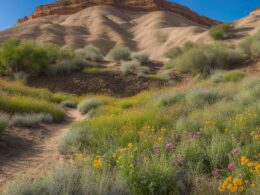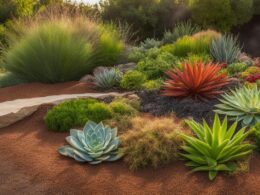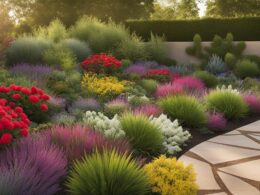Xeriscape gardening is a creative and attractive landscaping approach that saves water. It is not just about rocks and cacti, but rather about using water-efficient principles to create a colorful and vibrant landscape. The term Xeriscape was coined by the Denver Water Department and is widely used in drier areas of the country. The principles of Xeriscape gardening include planning and design, soil improvement, practical turf, plant selection and placement, efficient irrigation, use of mulches, and appropriate maintenance. By implementing these strategies, you can enhance water conservation and plant health in your xeric garden.
Key Takeaways:
- Mulching is essential for water conservation and weed control in xeric gardens.
- Spread mulch about 3 inches deep over the soil to retain moisture and regulate temperature.
- Avoid using solid plastic sheets as mulch.
- Consider covering a major part of the mulched area with plants for visual appeal.
- Consult with nursery professionals to select the right mulch for your xeric garden.
Planning and Design in Xeriscape Gardening
When embarking on the journey of creating a xeric garden, one of the first and most crucial steps is to plan and design your landscape. The planning and design phase sets the foundation for a successful and water-efficient xeriscape garden. It involves considering various factors such as the layout of your property, including slopes, soils, drainage, and areas of limited turf.
An essential aspect of planning and design is to complement the site and structure by selecting plants that are well-suited to thrive in the specific conditions of your garden. Factors like sunlight exposure, soil type, and water availability should be taken into account when choosing plants. Consulting with a professional designer can be beneficial, especially if you need assistance in checking your plans or completing the entire design.
A well-thought-out design ensures that your xeric garden not only looks visually appealing but also functions efficiently in conserving water. It allows you to strategically place plants, create focal points, and incorporate hardscaping elements to enhance the overall aesthetic appeal. By starting with a solid plan and design, you set the stage for a thriving and sustainable xeric garden.
Benefits of Planning and Design in Xeriscape Gardening:
- Optimizes water efficiency by strategically placing plants according to their water requirements
- Creates a visually appealing and cohesive landscape design
- Considers factors like soil type, sunlight exposure, and drainage for plant suitability
- Allows for the incorporation of hardscaping elements for added interest and functionality
- Saves time and effort by avoiding costly mistakes and rework
By prioritizing the planning and design phase, you lay the groundwork for a successful xeriscape garden that not only conserves water but also enhances the beauty and functionality of your outdoor space. So take the time to carefully plan and design your xeric garden, and you’ll reap the rewards for years to come.
Soil Improvement in Xeriscape Gardening
One of the key elements in creating a successful xeric garden is soil improvement. By enhancing the quality of the soil, you provide a solid foundation for your plants to thrive and conserve water effectively. To prepare your soil, it is recommended to add 3 to 5 cubic yards of organic material per 1,000 square feet and rototill it to a depth of 6 inches.
Soil analysis can be a valuable tool in determining the specific needs of your garden. You can have your soil analyzed by the Oklahoma County Extension Office for further guidance. Understanding the composition of your soil will help you make informed decisions regarding amendments and fertilizers that will benefit your plants.
Incorporating organic matter into the soil not only improves its structure and drainage but also provides essential nutrients for plant growth. This promotes a healthy root system and increases the water-holding capacity of the soil. As a result, your xeric garden will be better equipped to withstand periods of drought and require less frequent irrigation.
| Benefits of Soil Improvement in Xeriscape Gardening | How to Improve the Soil |
|---|---|
| Enhanced water conservation | Add 3 to 5 cubic yards of organic material per 1,000 square feet |
| Improved plant health and growth | Rototill the organic material to a depth of 6 inches |
| Increased nutrient availability | Have your soil analyzed for better understanding |
| Better soil structure and drainage | Incorporate organic matter into the soil |
By prioritizing soil improvement in your xeric garden, you lay the groundwork for a thriving and sustainable landscape. Implementing the right techniques and amendments will not only save water but also contribute to the overall health and vitality of your plants.
Quote:
“Improving the soil is like building a strong foundation for your xeric garden. It sets the stage for healthy plant growth and efficient water conservation.” – Xeriscape Gardening Expert
Practical Turf in Xeriscape Gardening
Turf is an essential element of a xeric garden, but it can also be a major water consumer. When planning your xeric garden, it’s important to choose practical turf areas based on function and aesthetics, ensuring that you reduce the overall amount of traditional lawn.
There are different turfgrass species available, each with varying water requirements. Cool-season grasses like tall fescue, Kentucky bluegrass, and ryegrass have higher water needs, while hybrid bermudagrass, zoysiagrass, common bermudagrass, and buffalograss require less water. Consider the specific water requirements of different turfgrass species when selecting the right type for your xeric garden.
By choosing turfgrass species that require less irrigation, you can significantly reduce the water consumption of your xeric garden. This not only conserves water but also helps to create a more sustainable and environmentally friendly landscape. Additionally, reducing the amount of traditional lawn and incorporating more water-efficient plants can add visual interest and diversity to your garden.
Practical Turf Selection Tips:
- Select turfgrass species with lower water requirements
- Limit the amount of traditional lawn in your xeric garden
- Consider the aesthetics and functionality of different turf areas
- Choose turfgrass species that can thrive in the specific conditions of your garden
- Implement water-efficient irrigation practices to further reduce water usage
Table: Water Requirements of Common Turfgrass Species
| Turfgrass Species | Water Requirements |
|---|---|
| Tall Fescue | High |
| Kentucky Bluegrass | High |
| Ryegrass | High |
| Hybrid Bermudagrass | Low |
| Zoysiagrass | Low |
| Common Bermudagrass | Low |
| Buffalograss | Low |
By implementing practical turf strategies in your xeric garden, you can create a beautiful and water-efficient landscape that requires less maintenance and conserves valuable resources. Remember to consider the specific water requirements of different turfgrass species and choose those that align with your sustainability goals. With the right turf selection and efficient irrigation practices, your xeric garden will flourish while reducing water consumption.
Use of Mulches in Xeriscape Gardening
Xeriscape gardening utilizes mulches as a key component to conserve moisture, suppress weed growth, and enhance the visual appeal of the landscape. Mulching is a simple yet effective technique that can significantly benefit your xeric garden. By understanding the different types of mulch and their applications, you can make informed choices to maximize the water conservation in your garden.
The Benefits of Mulching
Mulching offers numerous benefits to a xeric garden. Firstly, it helps retain moisture in the soil by reducing evaporation, thus reducing the need for frequent watering. This is especially important in arid climates where water is scarce. Secondly, mulch acts as a natural weed barrier, preventing weed seeds from germinating and competing with your plants for resources. This reduces the amount of time and effort spent on weeding. Lastly, mulch adds visual interest to your garden by providing a consistent and uniform ground cover, creating a more cohesive and appealing landscape.
Choosing the Right Mulch
There are various types of mulches to choose from, including organic and inorganic options. Organic mulches, such as wood chips, straw, or compost, decompose over time and enrich the soil with nutrients. They also improve soil structure and increase its ability to retain water. Inorganic mulches, like gravel or pebbles, do not decompose and provide a more permanent ground cover. When selecting mulch, consider factors such as the specific water needs of your plants, aesthetic preferences, and availability. Consult with nursery professionals to determine the most suitable mulch for your xeric garden.
Applying Mulch Properly
To ensure maximum benefits, it is important to apply mulch correctly. Start by clearing the area of any weeds or debris. Spread a layer of mulch approximately 3 inches deep around your plants, leaving some space around the base of the stem or trunk to prevent rot. Avoid placing mulch against the stems or trunks of plants, as this can create a favorable environment for pests and diseases. Mulch should cover a significant portion of the garden bed, but also allow space for plants to grow and breathe. Regularly check the mulch layer and replenish as needed to maintain the desired depth and effectiveness.
| Type of Mulch | Advantages | Disadvantages |
|---|---|---|
| Wood chips | Slowly decompose, enrich soil, suppress weeds | May attract pests or fungus, require periodic replacement |
| Straw | Inexpensive, lightweight, decomposes into organic matter | May contain weed seeds, may blow away in windy conditions |
| Gravel | Allows water drainage, long-lasting, provides heat reflection | Does not enrich soil, may heat up in direct sunlight |
| Pebbles | Low maintenance, visually appealing, does not decompose | Does not enrich soil, may migrate or shift over time |
Table: Comparison of Different Mulch Types
Implementing mulching strategies is an effective way to conserve water, suppress weeds, and enhance the beauty of your xeric garden. By choosing the right mulch and applying it properly, you can create a sustainable and visually appealing landscape that thrives in water-efficient principles. Start incorporating mulches into your xeriscape gardening today and reap the benefits for years to come.
Efficient Irrigation in Xeriscape Gardening
When it comes to xeriscape gardening, efficient irrigation practices are crucial for conserving water and maintaining a sustainable landscape. By implementing the right irrigation strategies, you can ensure that your xeric garden thrives while minimizing water usage.
To start, it’s important to separate the irrigation system for turf areas from other plantings. By using a zone system that groups plants based on their water requirements, you can avoid overwatering and ensure that each area receives the appropriate amount of moisture. This targeted approach not only saves water but also promotes the health and longevity of your plants.
A great tool for efficient irrigation in xeriscape gardening is drip irrigation. Drip systems deliver water directly to the root zone of plants, reducing evaporation and minimizing the growth of weeds. By using drip irrigation, you can further optimize water usage and create a more sustainable garden.
| Benefits of Efficient Irrigation | Challenges of Efficient Irrigation |
|---|---|
|
|
Efficient irrigation is a key component of xeriscape gardening. By properly designing your irrigation system and utilizing practices such as zone watering and drip irrigation, you can maximize water conservation while still enjoying a beautiful and thriving xeric garden.
Remember, the goal of efficient irrigation is to provide your plants with just the right amount of water they need, without wasting any. By taking the time to plan and implement an efficient irrigation system, you can contribute to water conservation efforts while creating a sustainable and visually appealing xeriscape garden.
What Are the Best Mulching Strategies for Xeric Gardens?
When it comes to mulching for xeriscape weed control, using organic materials like wood chips or straw can help conserve moisture and suppress weed growth. Additionally, strategically placing mulch around plants and in garden pathways can help maintain soil temperature and prevent water evaporation in xeric gardens.
Appropriate Maintenance and Conclusion
Proper maintenance is crucial to preserve the beauty and water efficiency of your xeric garden. By following a few key practices, you can ensure that your garden remains vibrant and sustainable for years to come.
Start by maintaining the proper mowing height for your turf areas. This will promote healthy growth and reduce water consumption. Additionally, regular fertilizing will provide essential nutrients to your plants and help them thrive in their water-efficient environment.
Pruning is another important task in xeric gardening. By removing dead or overgrown branches, you can improve the overall health and appearance of your plants. Keep an eye out for weeds as well, as they can compete with your plants for water and nutrients. Regularly remove weeds to maintain a clean and well-maintained garden.
Lastly, fine-tune your irrigation system to ensure optimal water usage. Adjust the watering schedule based on weather conditions and follow recommended guidelines for lawn watering. This will help prevent water waste and promote efficient water conservation.
In conclusion, by implementing appropriate maintenance practices, you can enjoy the full potential of your xeric garden. By taking care of your plants and fine-tuning your irrigation system, you can create a beautiful, water-efficient landscape that will thrive for years to come. Start maintaining your xeric garden today and reap the benefits of a vibrant and sustainable outdoor space.














